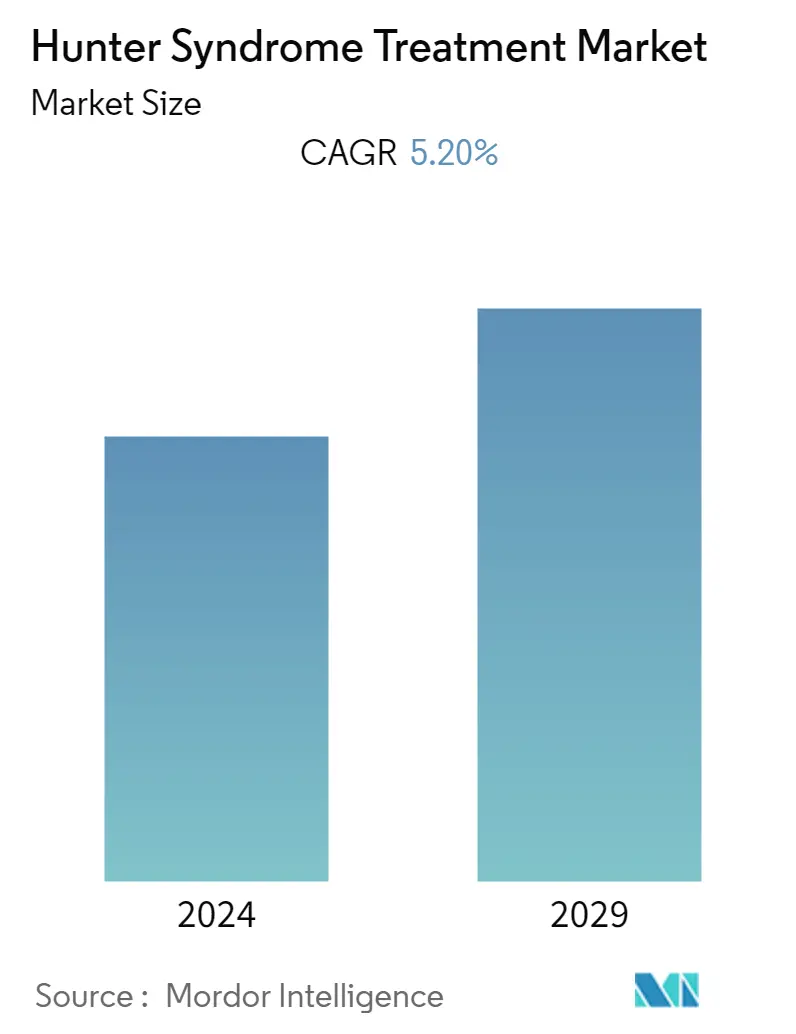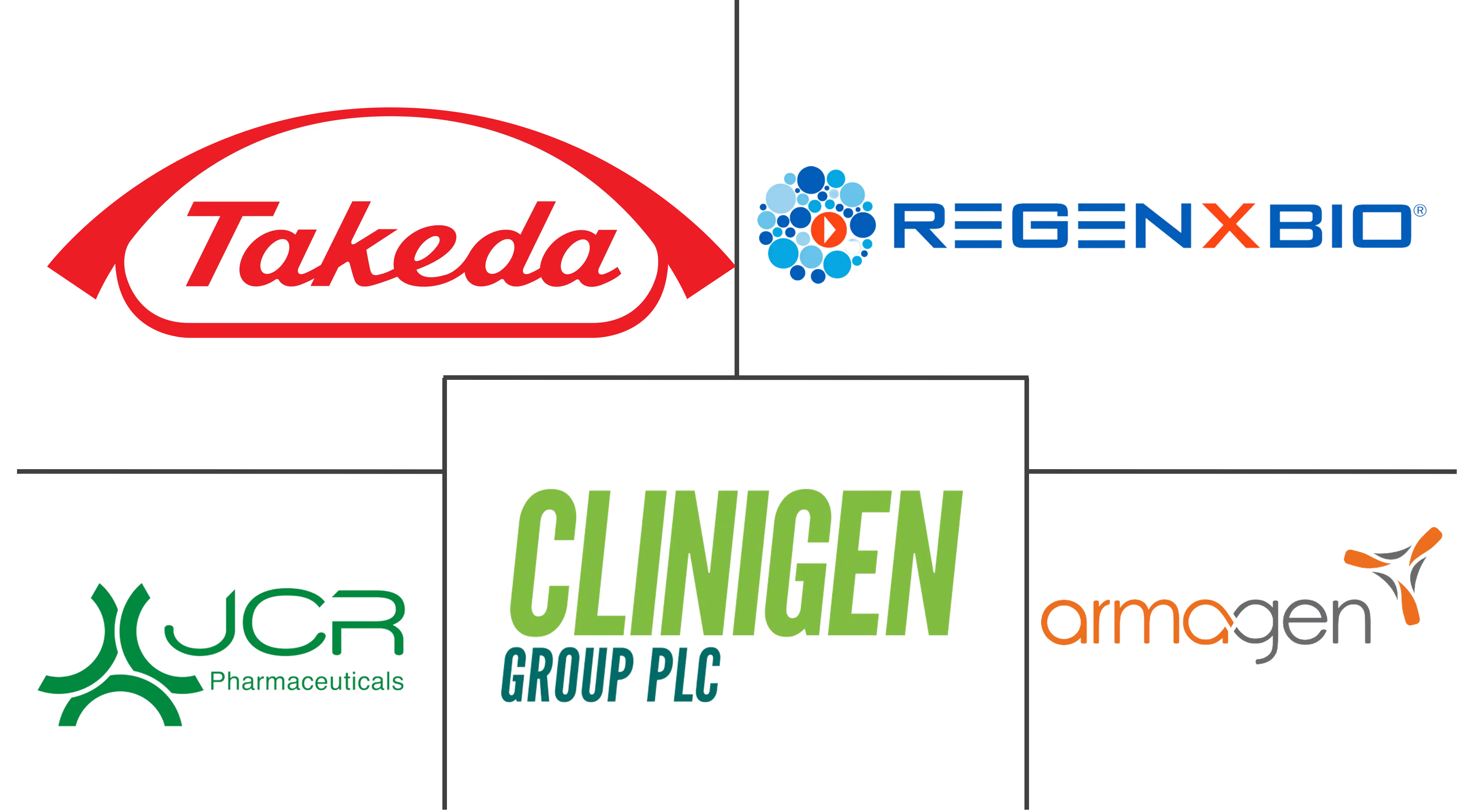Market Size of Hunter Syndrome Treatment Industry

| Study Period | 2021 - 2029 |
| Base Year For Estimation | 2023 |
| CAGR | 5.20 % |
| Fastest Growing Market | Asia Pacific |
| Largest Market | North America |
| Market Concentration | Medium |
Major Players
*Disclaimer: Major Players sorted in no particular order |
Hunter Syndrome Treatment Market Analysis
The hunter syndrome treatment market is expected to be valued at USD 1,265 million, at a CAGR of nearly 5.2%, during the forecast period.
The COVID-19 pandemic impacted the growth of the hunter syndrome market. For instance, according to a study published in BMC, in September 2021, lysosomal storage diseases (LSDs), including mucopolysaccharidosis II (MPS II, hunter syndrome), and others have shown that COVID-19 negatively impacted LSD patients' access to continuous care and therapy. The risk of getting COVID-19 was higher in patients with LSDs than in the general population. As per a study published in BMC, in October 2021, about 20% of patients receiving enzyme replacement therapy (ERT) in a hospital setting experienced treatment disruptions due to the COVID-19 pandemic. Thus, the delayed treatment services impacted the market's growth during the pandemic. However, the market started to recover in the later phases of the pandemic, which was reflected in the rising number of product developments and product approvals. For instance, in January 2021, GC Pharma received Japanese manufacturing and marketing approval for a Hunterase ICV (intracerebroventricular) injection of 15 mg as a treatment for mucopolysaccharidosis type II (hunter syndrome).
Certain factors that are attributing to the market's growth are increasing government initiatives, the introduction of novel therapies, and robust pipelines for treating hunter syndrome.
The rising burden of hunter diseases and the increasing patient population led to a rise in R&D and drug discovery, which is expected to increase the market's growth over the forecast period. For instance, in September 2021, Takeda Pharmaceuticals entered an exclusive collaboration and license agreement with JCR Pharmaceuticals to commercialize JR-141, an investigational next-generation recombinant fusion protein of an antibody against the human transferrin receptor and iduronate-2-sulfatase (IDS) enzyme for the treatment of Hunter syndrome. Under the terms of the agreement, Takeda commercialized JR-141 outside of the United States, including Canada, Europe, and other regions (excluding Japan and certain other Asia-Pacific countries). JCR received an upfront payment for such an ex-US license and is eligible to receive additional development and commercial milestones, as well as tiered royalties on potential sales. Such developments are expected to increase the availability of drugs and therapies in the market, thus boosting its growth over the forecast period.
The growing focus on conducting various R&D activities by companies to launch new products for treating hunter diseases is also contributing to the market's growth. For instance, in September 2022, ROBIO Inc. announced that the UK MHRA, Research Ethics Committee (REC), and Health Research Authority (HRA) approved AVROBIO's collaborators for the initiation of the Phase 1/2 clinical trial of investigational autologous hematopoietic stem cell (HSC) gene therapy in infants diagnosed with neuronopathic mucopolysaccharidosis/hunter disease.
The increasing government and organization focus on adopting various strategies such as collaborations and partnerships for developing effective drugs and treatment options are contributing to the growth of the market. For instance, in June 2022, the National MPS Society and Genetic Alliance partnered with Luna to accelerate the development of therapies for treating hunter syndrome in patients. In December 2021, the National MPS Society, Luna, and Genetic Alliance launched a digital drug discovery community in partnership with Takeda Pharmaceutical Company Limited to advance the development of therapeutic interventions for patients with mucopolysaccharidosis type II (MPS II), also known as hunter syndrome.
Therefore, owing to such developments, the market is expected to grow over the forecast period. However, the high treatment costs are likely to impede the market's growth over the forecast period.
Hunter Syndrome Treatment Industry Segmentation
As per the scope of the report, hunter syndrome, also known as mucopolysaccharidosis II or MPS II, is a type of rare disease caused by a lysosomal enzyme or iduronate-2-sulfatase enzyme deficiency. Enzyme replacement therapy (ERT) and hematopoietic stem cell transplant (HSCT) are the two main types of treatment that focus on providing symptomatic relief and managing complications associated with the disease.
The hunter syndrome treatment market is segmented by treatment type (enzyme replacement therapy (ERT), hematopoietic stem cell transplant (HSCT), and other treatment types), end user (hospitals, diagnostic centers, and other end users), and geography (North America, Europe, Asia-Pacific, and Rest of the World). The report offers the value (in USD million) for the above segments.
| By Treatment Type | |
| Enzyme Replacement Therapy (ERT) | |
| Hematopoietic Stem Cell Transplant (HSCT) | |
| Other Treatment Types |
| By End User | |
| Hospitals | |
| Diagnostic Centers | |
| Other End Users |
| By Geography | ||||||||
| ||||||||
| ||||||||
| ||||||||
| Rest of the World |
Hunter Syndrome Treatment Market Size Summary
The hunter syndrome treatment market is poised for significant growth, driven by increasing government initiatives, the introduction of novel therapies, and a robust pipeline of treatments. The market experienced disruptions during the COVID-19 pandemic, which affected patient access to continuous care and therapy, but has since shown signs of recovery with rising product developments and approvals. Key players in the industry are focusing on research and development to launch new products, with collaborations and partnerships playing a crucial role in advancing therapeutic interventions. The enzyme replacement therapy segment is expected to witness substantial growth due to its high efficacy and safety, alongside the increasing availability of such therapies and less stringent guidelines for rare diseases.
North America is anticipated to experience healthy growth, supported by rising awareness of rare diseases, favorable regulations for orphan drug development, and robust healthcare infrastructure. The region's market growth is further bolstered by technological advancements and the adoption of novel therapies. The competitive landscape of the hunter syndrome treatment market is moderately intense, with major players like REGENXBIO Inc., Takeda Pharmaceutical Company Limited, and JCR Pharmaceuticals leading the charge through strategic collaborations, product launches, and approvals. The ongoing clinical trials and the focus on developing safe treatment options are expected to contribute significantly to the market's expansion over the forecast period.
Hunter Syndrome Treatment Market Size - Table of Contents
-
1. MARKET DYNAMICS
-
1.1 Market Overview
-
1.2 Market Drivers
-
1.2.1 Increasing Government Initiatives
-
1.2.2 Introduction of Novel Therapies
-
1.2.3 Robust Pipelines
-
-
1.3 Market Restraints
-
1.3.1 High Treatment Costs
-
-
1.4 Porter's Five Forces Analysis
-
1.4.1 Threat of New Entrants
-
1.4.2 Bargaining Power of Buyers/Consumers
-
1.4.3 Bargaining Power of Suppliers
-
1.4.4 Threat of Substitute Products
-
1.4.5 Intensity of Competitive Rivalry
-
-
-
2. MARKET SEGMENTATION (Market Size by Value - USD million)
-
2.1 By Treatment Type
-
2.1.1 Enzyme Replacement Therapy (ERT)
-
2.1.2 Hematopoietic Stem Cell Transplant (HSCT)
-
2.1.3 Other Treatment Types
-
-
2.2 By End User
-
2.2.1 Hospitals
-
2.2.2 Diagnostic Centers
-
2.2.3 Other End Users
-
-
2.3 By Geography
-
2.3.1 North America
-
2.3.1.1 United States
-
2.3.1.2 Canada
-
2.3.1.3 Mexico
-
-
2.3.2 Europe
-
2.3.2.1 Germany
-
2.3.2.2 United Kingdom
-
2.3.2.3 France
-
2.3.2.4 Italy
-
2.3.2.5 Spain
-
2.3.2.6 Rest of Europe
-
-
2.3.3 Asia-Pacific
-
2.3.3.1 China
-
2.3.3.2 Japan
-
2.3.3.3 India
-
2.3.3.4 Australia
-
2.3.3.5 South Korea
-
2.3.3.6 Rest of Asia-Pacific
-
-
2.3.4 Rest of the World
-
-
Hunter Syndrome Treatment Market Size FAQs
What is the current Hunter Syndrome Treatment Market size?
The Hunter Syndrome Treatment Market is projected to register a CAGR of 5.20% during the forecast period (2024-2029)
Who are the key players in Hunter Syndrome Treatment Market?
REGENXBIO Inc., Clinigen Group plc, JCR Pharmaceuticals, ArmaGen and Takeda Pharmaceutical Company Limited (Shire) are the major companies operating in the Hunter Syndrome Treatment Market.

